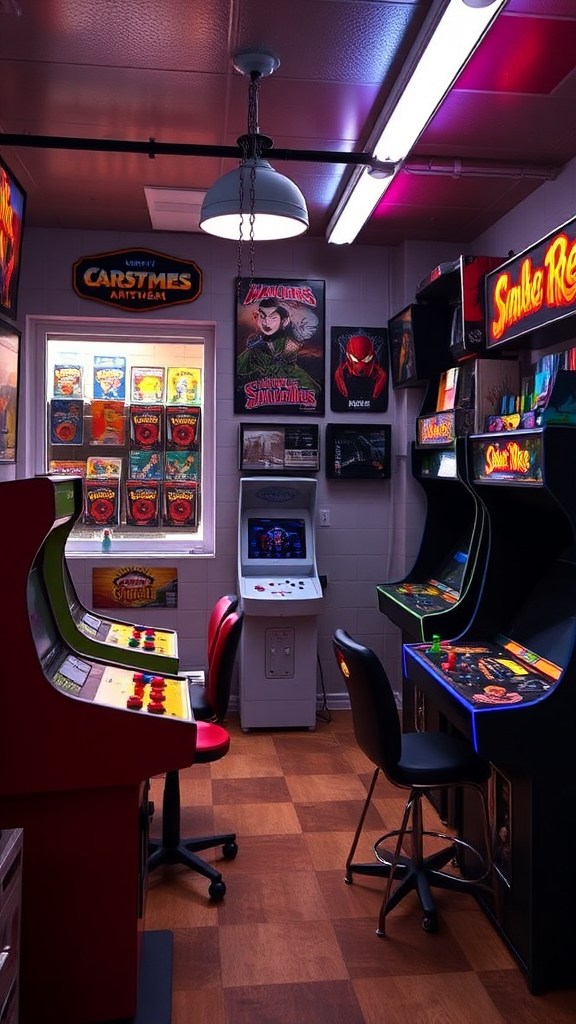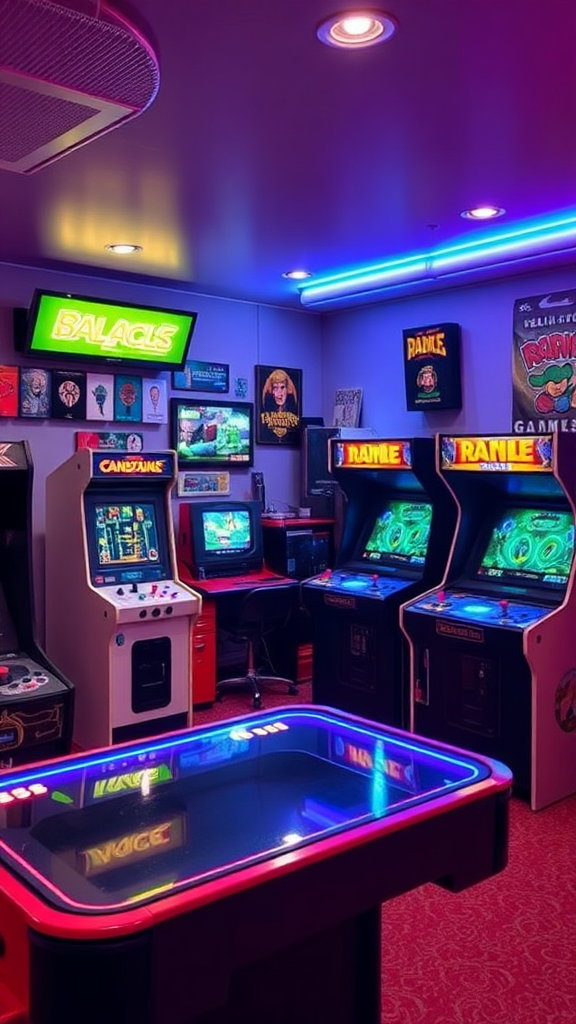
Introduction
Effortlessly cool and eternally nostalgic, retro game rooms have carved a unique niche in the world of gaming. Whether it’s the timeless appeal of arcade machines, the joy of classic game cartridges, or the vibrant posters and neon signs, these spaces transport us back to the golden era of gaming. If you’re ready to turn back time and create your own retro game room, this guide will take you through the essentials—from decor and game selection to presentation and expert tips. Get ready to immerse yourself in a world of pixelated adventures and old-school fun.
Ingredients for a Thriving Retro Game Room
- Classic Consoles and Cartridges: No retro game room is complete without classic gaming consoles like the NES, Sega Genesis, or Atari 2600. These systems, along with a selection of beloved games, form the heart of your retro experience.
- Arcade Machines: Choose either original arcade cabinets or modern replicas that mimic the look and feel of classics like Pac-Man, Donkey Kong, or Space Invaders.
- Decorative Pieces: Incorporate posters, neon signs, and pixel art to evoke the retro aesthetic. Think geometric patterns, bold colors, and memorabilia from your favorite games and gaming eras.
- Retro Furniture: Boldly colored sofas, vintage chairs, and old-style coffee tables complete the look. Mixing and matching items from the ’70s, ’80s, and ’90s can create a unique time-travel feel.
- Sound System: Enhance the gaming ambiance with a sound system that can blast tunes from your favorite gaming soundtracks or era-appropriate music.
Timing
Building a retro game room is a labor of love and can take anywhere from a few weeks to several months, depending on the size and extent of your vision. Start by gathering the essentials (consoles, games, decor) and gradually build out the space as you find rare or special additions. The joy is in the journey, not just the destination.
Step-by-Step Instructions
- Choose a Space: Find a room that can accommodate your vision, be it a spare bedroom, basement, or garage. Consider factors like lighting, ventilation, and existing electrical sockets.
- Set a Theme: While a broad “retro” theme works well, you might want to focus on a particular era (e.g., ’80s arcade or ’90s console gaming), color scheme, or game franchise to guide your decor choices.
- Acquire Hardware: Start with the consoles you’re most nostalgic for, whether it’s the Nintendo Entertainment System (NES), Sega Dreamcast, or Sony PlayStation. Visit local flea markets, online auction sites, or specialized retro game stores.
- Set Up Games: Organize your game collection in a way that’s both visually pleasing and accessible. Consider wall-mounted shelves, glass display cases, or dedicated storage units for your cartridges and discs.
- Add Arcade Machines: Authentic arcade machines can be large investments, but companies like Arcade1Up offer smaller replicas that capture the vibe. Make space for players to move freely around them.
- Decorate: Neon lights, vintage movie posters, framed game art, and even pixelated wall stickers can transform the room. Incorporate rugs and furnishings that fit the chosen era.
- Sound and Vision: Ensure your sound system is positioned to provide an immersive experience without overwhelming the space. Consider setting up old-school tube TVs or CRT monitors for a true retro experience.
- Lighting: Illuminate the room with neon signs, lava lamps, or string lights to make it vibrant and inviting. Dimmer switches can help set the mood for different gaming sessions.
Nutritional Information (For the Soul)
Flexibility and personality are key! Your retro game room should reflect what you love about gaming history. Swap in items that resonate with your memories, whether they’re mainstream classics or your personal favorites.
Alternatives and Customizations
Consoles can be expensive or hard to find. Consider alternatives like retro game emulators and all-in-one systems such as the Nintendo Switch Online + Expansion Pack, which offers a library of classic games. Modern arcade sticks and controllers can mimic the arcade experience affordably.
If space is an issue, focus on a multi-use setup. For example, include a foldable table for board games or removable decor to revert the room to its original purpose when needed.
Serving Suggestions
A retro game room is best enjoyed with friends, family, and fellow gamers. Organize game nights with tournaments or high score challenges to foster community and competition.
Common Mistakes to Avoid
- Overcrowding: It’s tempting to cram everything you own into the room, but a cluttered space is less inviting and functional. Prioritize quality over quantity.
- Ignoring Maintenance: Old consoles need regular care. Learn basic cleaning and repair skills to keep everything in working order.
- Poor Cable Management: Exposed wires can ruin the aesthetic and pose safety hazards. Invest in wire organizers and use cable ties to keep things tidy.
- Forgetting Comfort: Make sure seating is comfortable for long gaming sessions, and incorporate tables for snacks and drinks.
Storing Tips
Use display shelves or wall mounts to showcase hardware and games. Protect cartridges and discs with dedicated storage cases to prevent damage. Label storage bins for cables, controllers, and peripherals to keep everything organized.
FAQs
- Where can I find retro games and consoles? Look to local game stores, online auction sites (like eBay), estate sales, and gaming conventions.
- How do I maintain old consoles and cartridges? Clean dust regularly and avoid exposure to direct sunlight and moisture. Replace capacitors on older systems if needed.
- What’s the best way to display my collection? Floating shelves, glass cabinet displays, and shadow boxes can effectively showcase your gear without cluttering the space.
- Can I integrate modern gaming consoles? Absolutely! A retro game room can also house modern systems to create a space that spans generations of gaming.
- How do I tackle wiring and power needs? Use surge protectors, keep cables organized and out of sight, and label power strips to avoid confusion during setup or troubleshooting.
Conclusion
Creating a retro game room is a tribute to gaming’s past, beautifully combining history with personal nostalgia. This project might take time, but the reward is a timeless, entertaining escape that allows you and your loved ones to relive the magic of bygone gaming eras.
So power up that NES, queue up some ’80s synthwave, and get ready to achieve that high score – your retro game room awaits!
For more inspiration and guides on gaming and design, check out our Game Design and Art category.

Beginning C++ Game Programming
Beginning C++ Game Programming: Learn to program with C++ by building fun games
Stefan\'s Body Mechanics Workflow
If you’ve been frustrated with the traditional 3D body mechanics workflows that are often promoted by online schools and tutorials, keep reading—I’ve got some exciting news for you.

